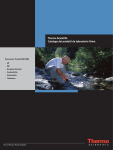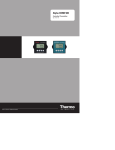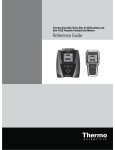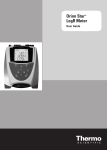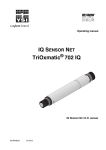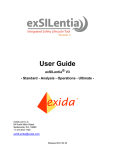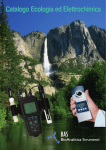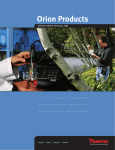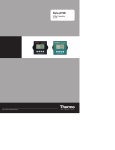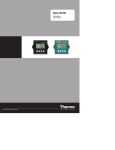Download User Guide
Transcript
User Guide Dissolved Oxygen Probes ROSS and the COIL trade dress are trademarks of Thermo Fisher Scientific Inc. AQUAfast, Cahn, ionplus, KNIpHE, No Cal, ORION, perpHect, PerpHecT, PerpHecTion, pHISA, pHuture, Pure Water, Sage, Sensing the Future, SensorLink, ROSS, ROSS Ultra, Sure-Flow, Titrator PLUS and TURBO2 are registered trademarks of Thermo Fisher. 1-888-pHAX-ION, A+, All in One, Aplus, AQUAsnap, AssuredAccuracy, AUTO-BAR, AUTO-CAL, AUTO DISPENSER, Auto-ID, AUTO-LOG, AUTO-READ, AUTO-STIR, Auto-Test, BOD AutoEZ, Cable-Free, CERTI-CAL, CISA, DataCOLLECT, DataPLUS, digital LogR, DirectCal, DuraProbe, Environmental Product Authority, Extra Easy/Extra Value, FAST QC, GAP, GLPcal, GLPcheck, GLPdoc, ISEasy, KAP, LabConnect, LogR, Low Maintenance Triode, Minimum Stir Requirement, MSR, NISS, One-Touch, One-Touch Calibration, One-Touch Measurement, Optimum Results, Orion Star, Pentrode, pHuture MMS, pHuture Pentrode, pHuture Quatrode, pHuture Triode, Quatrode, QuiKcheK, rf link, ROSS Resolution, SAOB, SMART AVERAGING, Smart CheK, SMART STABILITY, Stacked, Star Navigator 21, Stat Face, The Enhanced Lab, ThermaSense, Triode, TRIUMpH, Unbreakable pH, Universal Access are trademarks of Thermo Fisher. © 2007 Thermo Fisher Scientific Inc. All rights reserved. All trademarks are the property of Thermo Fisher Scientific Inc. and its subsidiaries. The specifications, descriptions, drawings, ordering information and part numbers within this document are subject to change without notice. This publication supersedes all previous publications on this subject. Introduction This user guide contains information on the preparation, operation and maintenance of the Thermo Scientific Orion dissolved oxygen probes. These DO probes are compatible with a wide range of applications including water and wastewater analysis, beer and wine testing, rugged field applications, and BOD (Biochemical Oxygen Demand) analysis. All the DO probes feature automatic temperature compensation and convenient screw on membrane caps. Various probe features and accessories are available that allow you to customize a DO probe to your specific needs. Thermo Scientific Orion Dissolved Oxygen Probes Star Series DO Probes Star Series DO probes have a 9 pin MiniDIN connector that ensures a waterproof and secure connection when used with the Orion Star Series DO meters. 080510MD 083010MD 081010MD 083025MD 083005MD 083060MD A+ Series DO Probes A Series DO probes have an 8 pin DIN connector for use with any DO meter with an 8 pin DIN input. These probes are compatible with the A+ Series DO meters. 083005D 018010 081010F Waterproof DO Probes Waterproof DO probes have an 8 pin waterproof DIN connector for use with any DO meter with an 8 pin waterproof DIN input. These probes are compatible with the 830A, 835A and 862A DO meters. 083005A 083150A 083010A Dissolved Oxygen Probe User Guide 083010F Required Equipment 1. Thermo Scientific Orion DO meter, such as the 3-Star DO meter, 4-Star pH/DO meter, or 5-Star pH/ISE/DO/ conductivity meter. 2. Thermo Scientific Orion DO probe. 3. Polarographic electrolyte solution, Cat. No. 080514. 4. DO probe maintenance kit. Dissolved Oxygen Probe Maintenance Kit 080510MD, 081010MD, 081010 080113 083005MD, 083010MD, 083025MD, 083060MD, 083005D, 081010F, 083005A, 083010A,083010F, 083150A 080513 5. Magnetic stirrer or Orion stirrer probe, Cat. No. 096019. The stirrer probe can be used with 3-Star, 4-Star, and 5-Star benchtop meters. 6. Polishing disks. 7. Calibration sleeve or BOD bottle. 8. Membrane caps. Dissolved Oxygen Probe Membrane Cap 080510MD, 081010MD, 081010 081003 (Pack of 3) 083005MD, 083010MD, 083025MD, 083060MD, 083005D, 081010F, 083005A, 083010A,083010F, 083150A 080515 9. Beakers. 10. Distilled or deionized water. Dissolved Oxygen Probe User Guide DO Probe Preparation 1. Unscrew the membrane cap from the probe and remove any electrolyte solution from the cap. Rinse the inside and outside of the cap with distilled water and blot dry. 2. Rinse the probe anode/cathode assembly with distilled water and blot dry. 3. Fill the membrane cap about ¾ full with new electrolyte solution. 4. Screw the membrane cap onto the probe until the cap is hand tight. 5. Polarize the probe. The probe must be polarized before use. To polarize a new probe, attach the probe to the meter, connect the meter to a power supply, and wait 30 to 60 minutes. The probe is continuously polarized when it is connected to the meter, so this process does not need to be repeated unless probe maintenance is performed or the probe is disconnected from the meter for more than an hour. If the probe is disconnected from the meter for less than an hour, allow the probe to polarize for 5 to 25 minutes before use. Dissolved Oxygen Probe User Guide Protective Probe Guard Assembly of the Protective Probe Guard Insert the probe cable (1) into the slot in the clamping ring (3) with the recessed side placed on the top of the probe cap (4). Insert the probe connector into the threaded side of the retainer (2) and pull the cable through the hole until the clamping ring is seated flush in the retainer. Slide the probe retainer nut (5) over the probe body and screw it into the retainer threads until hand tight. Do not overtighten the probe retainer nut. Screw the probe body sleeve (6) onto the retainer threads until hand tight. Disassembly of the Protective Probe Guard Remove the probe body sleeve (6) by unscrewing it. Remove the probe retainer nut (5) from the retainer (2) by unscrewing it. Slide the probe out of the retainer so that the clamping ring (3) can be removed without obstruction. Continue pulling the probe cable (1) through the retainer, taking care not to lose the clamping ring. Slide the clamping ring away from probe cap (4) and off of the strain relief so that it can easily be removed from the probe cable. To prevent loss of components, reassemble the protective sleeve before storing the assembly. Note: Do not place excessive force on the probe cable when disassembling as this may damage the cable. s Figure 1: 080510MD DO probe with guard 1 2 3 4 5 6 Figure 2: 080510MD DO probe Dissolved Oxygen Probe User Guide DO Probe Calibration Calibration of a polarographic DO probe can be done quickly and conveniently using the water-saturated air method. Under equilibrium conditions, the partial pressure of oxygen in airsaturated water is equal to the partial pressure of oxygen in water-saturated air (air at 100% relative humidity). This means that a probe calibrated in water-saturated air will correctly read the partial pressure of oxygen in a water sample. Since the diffusion rate of oxygen in water and air differs slightly, meters apply a correction factor to the water-saturated air calibration value to obtain the correct air-saturated water value. The correction factor is 102.3%. When measuring a low concentration sample (less than 2 ppm), a second calibration point for a zero oxygen standard is often recommended. Calibration Sleeve or BOD Bottle Preparation To prepare the calibration sleeve, remove the cap from the sleeve and remove the sponge from the cap. Saturate the sponge with distilled water and then squeeze all the excess water out of the sponge. Reassemble the calibration sleeve and insert the DO probe. To prepare a BOD bottle, fill the bottle with about 50 mL of distilled water. Insert the probe into the BOD bottle (a BOD bottle adapter is required for the DO probe to fit directly into the bottle). Make sure the probe is suspended about half an inch above the distilled water and there is no water on the surface of the DO probe. Note: A DO reading of zero and no change in temperature may indicate that the DO probe is not fully connected to the meter. Firmly reconnect the DO probe to the meter and take a new measurement. s Polarization A new probe must be polarized before calibration. To polarize a new probe, attach the probe to the meter, connect the meter to a power supply, and wait 30 to 60 minutes. The DO probe is continuously polarized when it is connected to the meter, so this process does not need to be performed unless probe maintenance is performed or the probe is disconnected from the meter for more than an hour. If the probe is disconnected from the meter for less than an hour, allow the probe to polarize for 5 to 25 minutes before use. Dissolved Oxygen Probe User Guide Dissolved Oxygen Measurement Hints Stirring Consumption of oxygen by the probe can cause a lowering of the oxygen concentration at the boundary layer between the sample and the probe membrane. For this reason, sample stirring is required. Membranes Two types are commonly used, loose membranes, and membrane cap assemblies. While loose membranes are less expensive, they are more difficult to install, and will give lower precision results. The stretch of the membrane determines how thick the electrolyte layer adjacent to the cathode is, which affects the time response of the probe. Thermo Scientific precision manufactured membrane cap assemblies give a reproducible electrolyte layer thickness, speed up probe servicing, and eliminate assembly problems. Electrolyte The electrolyte in any polarographic dissolved oxygen probe must be replaced periodically, after its capacity to reduce oxygen is depleted. The time the electrolyte lasts depends on the rate at which oxygen is reduced. Probes with a very small diameter cathode will typically have very low current, resulting in low oxygen consumption by the probe. This results in low stir sensitivity, as well as very long electrolyte life. Dissolved oxygen probes require electrolyte replacement every two weeks to six months, depending on usage and sample type. Dissolved Oxygen Probe User Guide DO Probe Maintenance 1. Unscrew the membrane cap from the probe and dispose of the electrolyte solution and membrane cap. 2. Place a few drops of distilled water on a polishing disk. Polish the probe cathode with the polishing disk for about 10 seconds. Polishing disks are included in the probe maintenance kits, Cat No. 080513 and 080113. 3. Rinse the probe anode/cathode assembly with distilled water and blot dry. 4. Fill a new membrane cap about ¾ full with new electrolyte solution. 5. Screw the membrane cap onto the probe until the membrane cap is hand tight. 6. Polarize the probe. The probe must be polarized before use. To polarize a probe, attach the probe to the meter, connect the meter to a power supply, and wait 30 to 60 minutes. The probe is continuously polarized when it is connected to the meter, so this process does not need to be repeated unless probe maintenance is performed or the probe is disconnected from the meter for more than an hour. If the probe is disconnected from the meter for less than an hour, allow the probe to polarize for 5 to 25 minutes before use. Recommended maintenance intervals are shown in the chart below. Dissolved Oxygen Probe Recommended Maintenance Period 080510MD, 081010MD, 081010 1 to 2 months 083005MD, 083010MD, 083025MD, 083060MD, 083005D, 081010F, 083005A, 083010A,083010F, 083150A 3 months Dissolved Oxygen Probe User Guide DO Probe Storage For short term storage: Overnight or between measurements the probe should remain attached to the meter and kept in a calibration sleeve or beaker with distilled water. For long-term storage: Disconnect the probe from the meter, unscrew the membrane cap, remove any electrolyte solution from the cap, rinse the probe anode/cathode assembly with distilled water and blot dry, and screw the membrane cap onto the probe until the membrane cap is hand tight. Do not fill the membrane cap with electrolyte solution; the probe should be stored dry. Troubleshooting The most important principle in troubleshooting is to isolate the components of the system and check each in turn. The components of the system are: the meter, probe, sample and technique. Meter The meter is the easiest component to eliminate as a possible cause of error. Thermo Scientific Orion meters include an instrument checkout procedure in the meter user guide. Consult the manual for complete instructions and verify that the instrument operates as indicated and is stable in all steps. Probe Rinse the probe thoroughly with distilled water and follow the cleaning procedure in the DO Probe Maintenance section. If readings continue to be erratic and unstable, you may need to replace the membrane cap, replenish electrolyte or polish the cathode with a polishing disk. Dissolved Oxygen Probe User Guide Sample If the probe works properly in standards but not in the sample, look for possible interferences or substances that could alter probe response or physically damage the probe. If possible, determine the composition of the samples and check for problems. Technique Check if the method of analysis is compatible with your sample. Assistance After troubleshooting all components of your measurement system, contact Technical Support. Within the United States call 1.800.225.1480 and outside the United States call 978.232.6000 or fax 978.232.6031. In Europe, the Middle East and Africa, contact your local authorized dealer. For the most current contact information, visit www.thermo.com/water. Warranty For the most current warranty information, visit www.thermo.com/water. Dissolved Oxygen Probe User Guide Troubleshooting Chart Issue Recommended Action Unable to calibrate Ensure that probe is fully polarized. See DO Probe Preparation section. Verify that no water droplets are on the membrane and there are no bubbles inside the membrane. Perform probe maintenance. See DO Probe Maintenance section. Unstable measurements Check that the solution is being stirred and the stir rate is sufficient. Measurements may take longer if the solution temperature is unstable. Ensure that probe is fully polarized. See DO Probe Preparation section. Perform probe maintenance. See DO Probe Maintenance section. Interfering substance may be present. Measured value too low Salt may be present in the sample. Set the salinity factor in the meter. Check that the solution is being stirred and the stir rate is sufficient Perform probe maintenance. See DO Probe Maintenance section. Wrong temperature displayed Verify that probe is properly connected to the meter Contact Technical Support Bad zero point calibration The probe must be immersed in an oxygen-free solution for at least five minutes. Interfering Substances Substances such as ozone, sulfides, sulfur dioxide, nitrous oxide and carbon monoxide may interfere with dissolved oxygen measurements. If the measurements are unstable and other troubleshooting procedures do not correct the problem, there may be interfering substances present in the solution. 10 Dissolved Oxygen Probe User Guide Ordering Information DO Probes Cat. No. Description 080510MD DO probe with plastic probe guard, 3 meter cable and 9 pin MiniDIN connector 081010MD DO probe with 3 meter cable and 9 pin MiniDIN connector 083005MD DO probe with calibration sleeve, 1.5 meter cable and 9 pin MiniDIN connector 083010MD DO probe with calibration sleeve, 3 meter cable and 9 pin MiniDIN connector 083025MD DO probe with calibration sleeve, 10 meter cable and 9 pin MiniDIN connector 083060MD DO probe with calibration sleeve, 20 meter cable and 9 pin MiniDIN connector 083005D DO probe with calibration sleeve, 1.5 meter cable and 8 pin DIN connection 081010 DO probe with 3 meter cable and 8 pin DIN connection 081010F DO probe with probe guard, 3 meter cable and 8 pin DIN connection 083005A DO probe with calibration sleeve, 1.5 meter cable and 8 pin waterproof DIN connection 083010A DO probe with calibration sleeve, 3 meter cable and 8 pin waterproof DIN connection 083010F DO probe with probe guard, 3 meter cable and 8 pin waterproof DIN connection 083150A DO probe with 50 meter cable and 8 pin waterproof DIN connection Dissolved Oxygen Probe User Guide 11 Ordering Information Accessories Cat. No. Description 080513 Maintenance kit for 083005MD, 083010MD, 083025MD, 083060MD, 083005D, 081010F, 083005A, 083010A, 083010F, and 083150A probes, includes (2) membrane caps, electrolyte solution and polishing disk 080113 Maintenance kit for 080510MD, 081010MD and 081010 probes, includes (2) membrane caps, electrolyte solution and polishing disk 080515 (1) Membrane cap for 083005MD, 083010MD, 083025MD, 083060MD, 083005D, 081010F, 083005A, 083010A, 083010F, and 083150A probes 081003 (3) Membrane caps for 080510MD, 081010MD and 081010 probes 080514 Polarographic electrolyte solution 080017 Calibration sleeve 080360 BOD adapter for 083005MD, 083010MD, 083025MD, 083060MD, 083005D, 081010F, 083005A, 083010A, 083010F, and 083150A probes 080160 BOD adapter for 080510MD, 081010MD, and 081010 probes 013045 Stainless steel probe guard 080045 Stainless steel and plastic probe guard 081045 Plastic probe guard 1010800 Adapter, 9 pin MiniDIN DO probe to 8 pin waterproof DIN DO meter (830A, 835A, and 862A meters) 1010801 Adapter, 9 pin MiniDIN DO probe to 8 pin DIN DO meter (805A+, 810A+, and 850A+ meters) 12 Dissolved Oxygen Probe User Guide Thermo Fisher Scientific Environmental Instruments Water Analysis Instruments 166 Cummings Center Beverly, MA 01915 USA Tel: 978-232-6000 Toll Free: 800-225-1480 Dom. Fax: 978-232-6015 Int’l. Fax: 978-232-6031 254778-001 Rev. A www.thermo.com/water

















